Have you ever asked yourself What is extra-virgin olive oil? Where does it come from? And how is it made? Hopefully this post will shed some light on some of your questions by narrating how small olive growers like my family make extra-virgin olive oil every fall for their own personal use.
The location
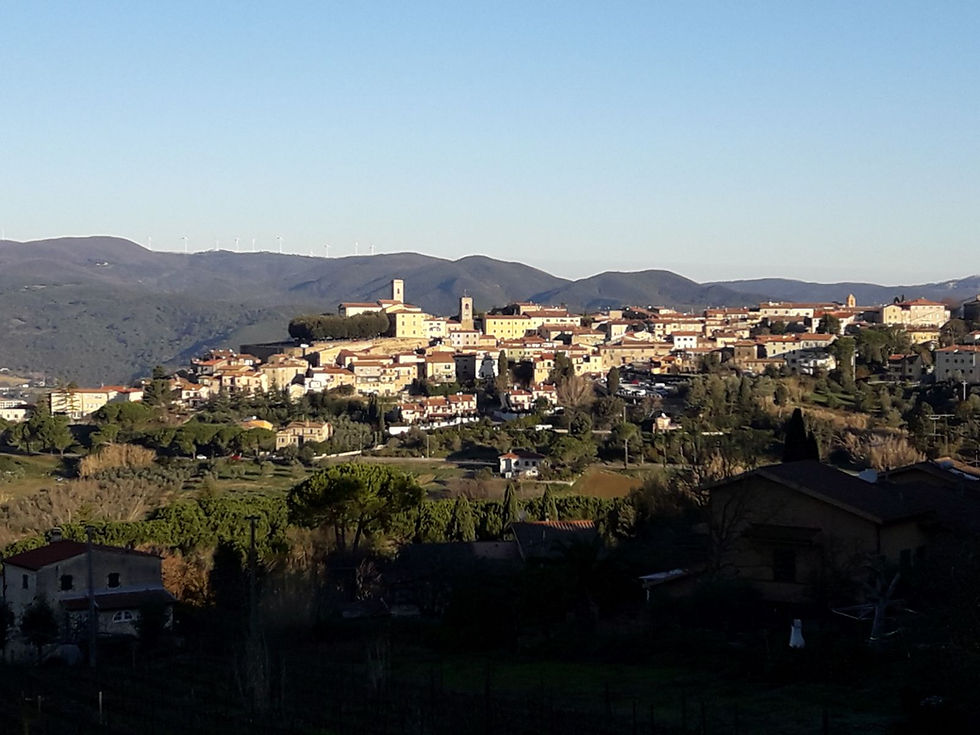
My parents live in Tuscany in the province of Pisa, in a small village called Montescudaio, 10 km from the beaches of Cecina and Bibbona. Montescudaio is situated on the top of a hill and it is a borgo - old village with less than 15,000 inhabitants. Its origin goes back to the XI century when the borgo had a Benedictine monastery and a castle of the family Della Gherardesca - an extremely powerful family of the Republic of Pisa (XI century - 1406) which had multiple properties in the territory that today coincides with the provinces of Pisa and Livorno. In 1846 there was a devastating earthquake in the area and as a consequence only the tower remains of the original castle. Many buildings were rebuilt after the earthquake thus, losing their characteristic Medieval architecture. Today Montescudaio has beautiful old stone houses and buildings among which the Palace Surbone, once residence of the aristocratic Ridolfi family, and villa Marchionneschi built in the 1800s. The borgo of Montescudaio is listed in the register of I Borghi piu belli d'Italia.
In the winter the borgo is very tranquil but in the summer with the arrival of visitors Motescudaio becomes lively especially along the main stretch where small shops that sell local products are situated. If you end up in the area try salami and other local meet products sold at the Sandri's shop. The bakery La Scalinata a few meters after the meat shop makes very good bread, schiaccia (a kind of focaccia typical to Tuscany - pronounced skiacha), and pastries. It is a small bakery (panetteria in Italian) so go early in the morning to have a better selection. The red wine Montescudaio rosso produced in the surrounding hills is a renowned wine and you can taste it in restaurants, enoteche (wine shops) and agriturismi (farmhouses) in Montescudaio.
The olive trees
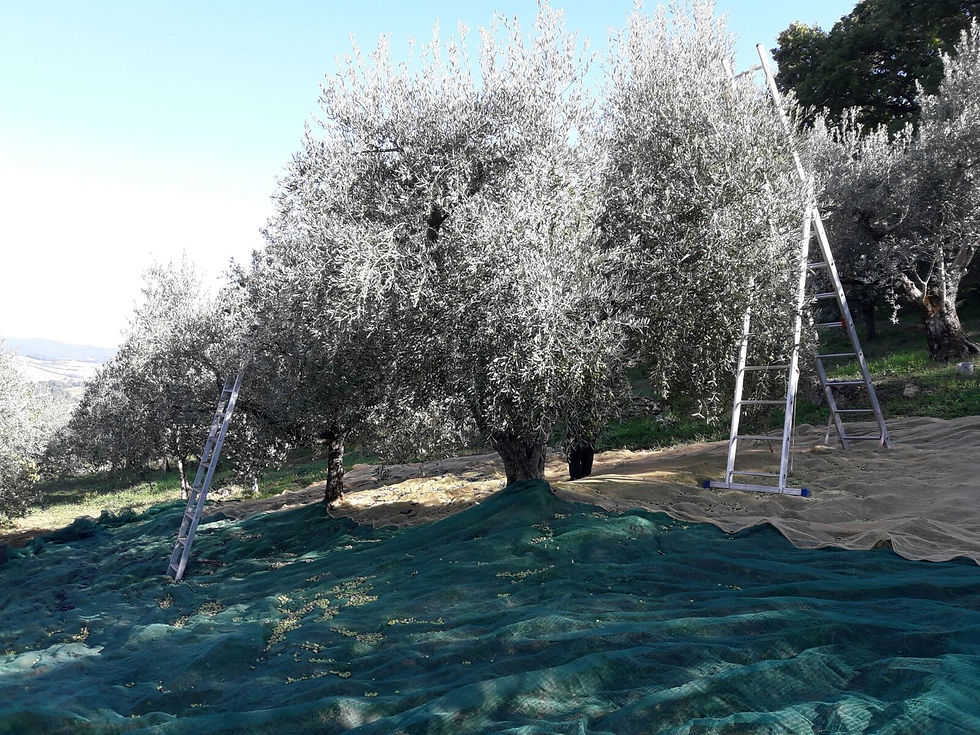
My family's small property is located in one of the surrounding hills of Montescuadio and it has 94 olive trees. Every year in the fall my parents harvest olives to make extra-virgin olive oil. Usually harvesting is sometimes in November but this year because of a warmer climate they did it earlier, in October! The olives were ripe and ready to be harvested. And that is how people have been deciding when to harvest, by watching the ripeness of the fruit. This is the traditional way of doing it. And my parents, like everybody else in the area follow the tradition. In their olive grove they have five varieties of olives, called cultivars: frantoio, leccino, pendolino, moraiolo, and lazzera or lazzero.
Five cultivars of olives: make an excellent extra-virgin olive oil!
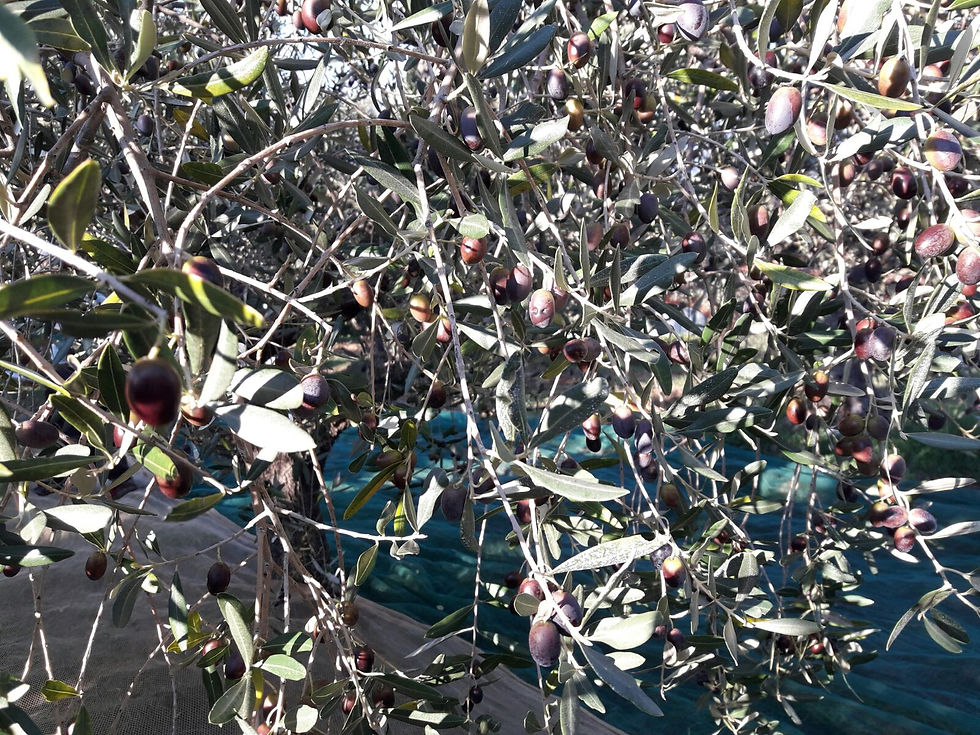
A mixture of multiple cultivars assures a high quality extra-virgin olive oil, characterized by a unique aroma, pungency, bitterness, color, and also fragrance. Let's take a look at the cultivars one by one.
1. Frantoio is self-pollinating and it is a wonderful pollinator for other cultivars. Its origin is from Tuscany, the color of the fruit is green or black. It produces fruits abundantly and constantly. The oil is aromatic, thin, tasty, and very valuable.
2. Leccino is pollinated by pendolino and frantoio. The color of the fruit is black and purplish. The fruit is used to make oil but also black olives to enjoy at the table.
3. Moraiolo is pollinated by frantoio, lazzera, and pendolino. The color of the fruit is purplish black. It is a Tuscan cultivar.
4. Pendolino pollinates well with frantoio, moraiolo, and leccino. It originated in the area around Florence, Tuscany. The color of the fruit is black. The oil is known for its sensory (organoleptic) properties. Organoleptic properties in food include taste, odor, color, and texture. These properties describe the sensory response one has when tasting the food due to a combination, for example of taste and smell.
5. Lazzera pollinates with moraiolo and leccino. Lazzera is a local cultivar, of color green or purplish black. Its origin is from Val di Cecina, where my family lives. This cultivar is grown to make olive oil that has good organoleptic properties like pendolino. Its fruit is also used to serve at the table.
The harvest
As I mentioned earlier the harvest takes place at the end of October or beginning of November, when the olives are ripe. Big nets are placed under the olive trees like in the picture below, these nets measure 25 x 5 meters. Once the nets are in place, the olives are harvested by hand or with the help of a small comb.
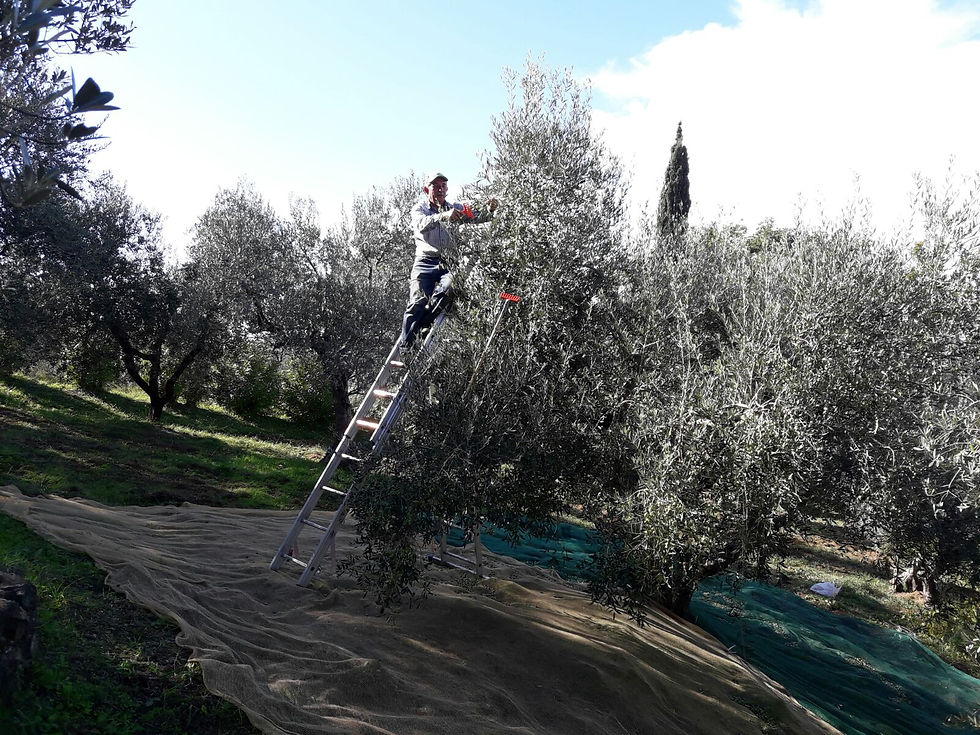
In the picture above my father is using a red comb to facilitate the process. The olives are then dropped on the nets below the trees. The same process is done tree by tree. Once the olives are on the nets it is easier to collect them.
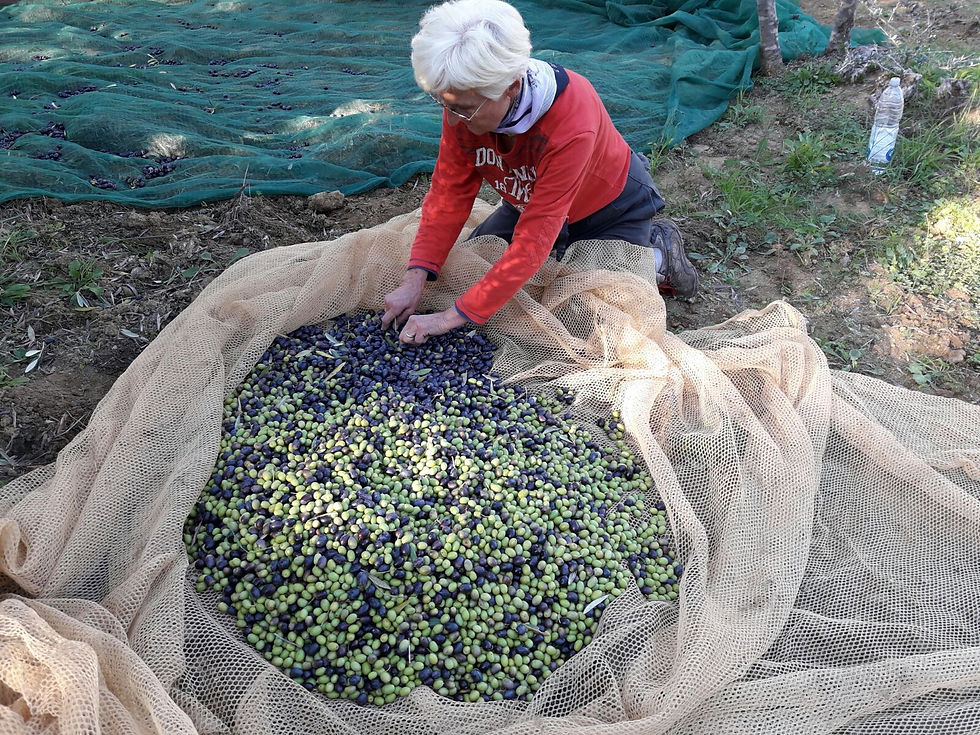
Nets are dragged near cases. Leaves and small branches are removed from the olives as much as possible (picture above). Olives are then placed in a plastic bin, in this case a 24 kg (48lb) bin, ready to be transported to the olive mill (frantoio).

I would like to clarify that the harvest takes days and my parents do a few trees at the time in order to be able to deliver the bins to the olive mill right after olives are harvested. When the pressing and crushing of the olives of the first mill run is done, they continue with the harvest of the next group of trees and so on. Timing is very important: to make a high quality extra-virgin olive oil, harvested olives must be taken to the olive mill as soon as possible. That means that my parents end up doing multiple runs to the olive mill.
The olive mill's schedule
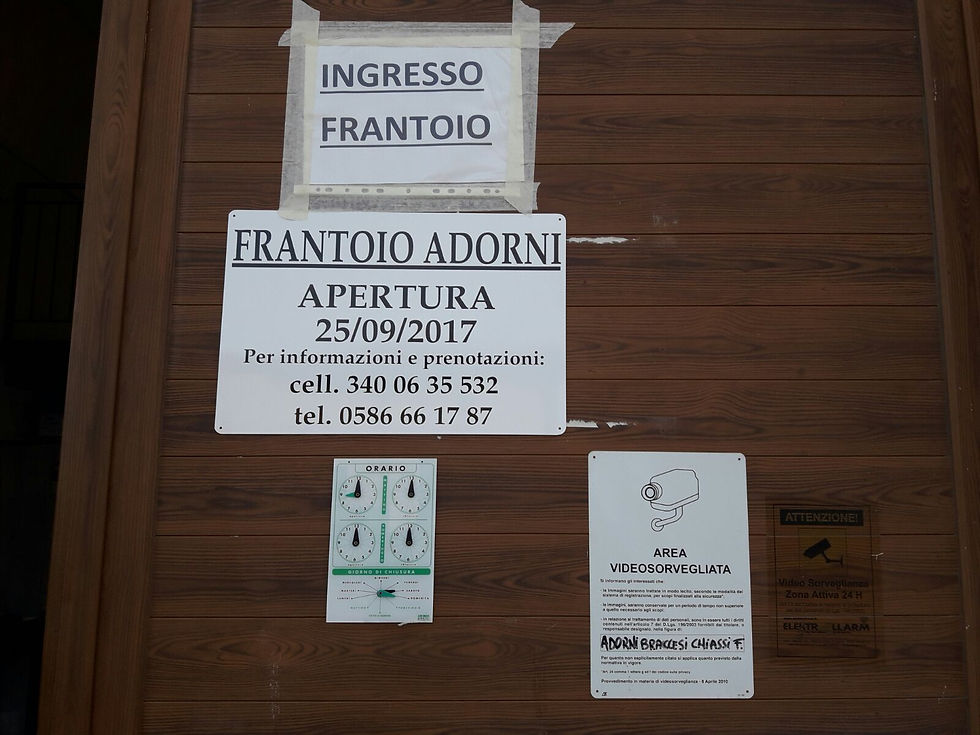
The olive mills open only once a year, when the olives are ripe and ready to be pressed and crushed. It works night and day and stays open until everybody is done bringing olives. This year the olive mill where my parents go in Cecina opened on September 25. Before going to the olive mill olive growers must schedule an appointment. My father delivers his first batch of olives to the olive mill at the time and day scheduled for him. When he is done with his first olive mill appointment, he will schedule the next one based on a estimate of how many olives remain to be harvested.
Visitors are not allowed in the olive mill during the process of olive oil making; only staff and olive growers are present.
At the olive mill
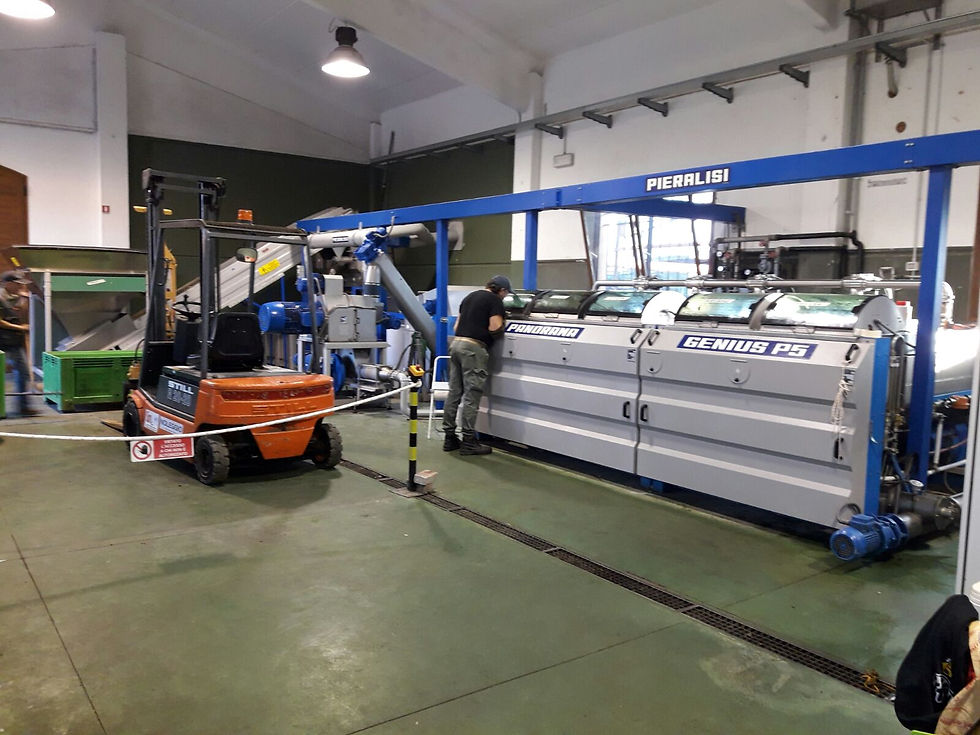
My father's olives are sitting in a 300 kilo green bin waiting to be placed inside the metal funnel (upper left in the above picture). Once inside the process of cleaning and washing will start. The olives then are ground into a paste. Next they end up in the big machinery in the center right of the picture above. This machinery has four tanks; every tank contains olive paste of a different olive grower up to six hundred kilos. The paste is mixed for approximately an hour. The timing of the mixing is on a different schedule per tank thus allowing a continuous flow of multiple clients.
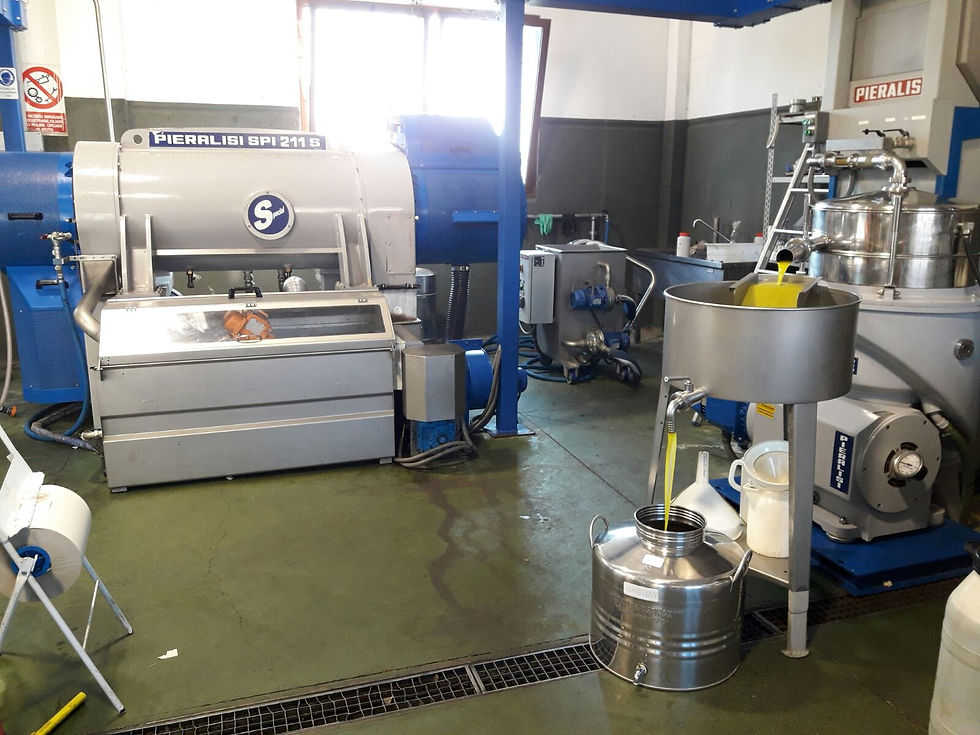
The paste will go in a centrifuge (left on the above picture) where the oil is separated from the rest of the olive components - water, solids. The left over paste is diverted to a different area of the olive mill.
The mill will use it to make more oil. This is the rule with the olive mill - it processes your olives but you have to leave your olive paste there.
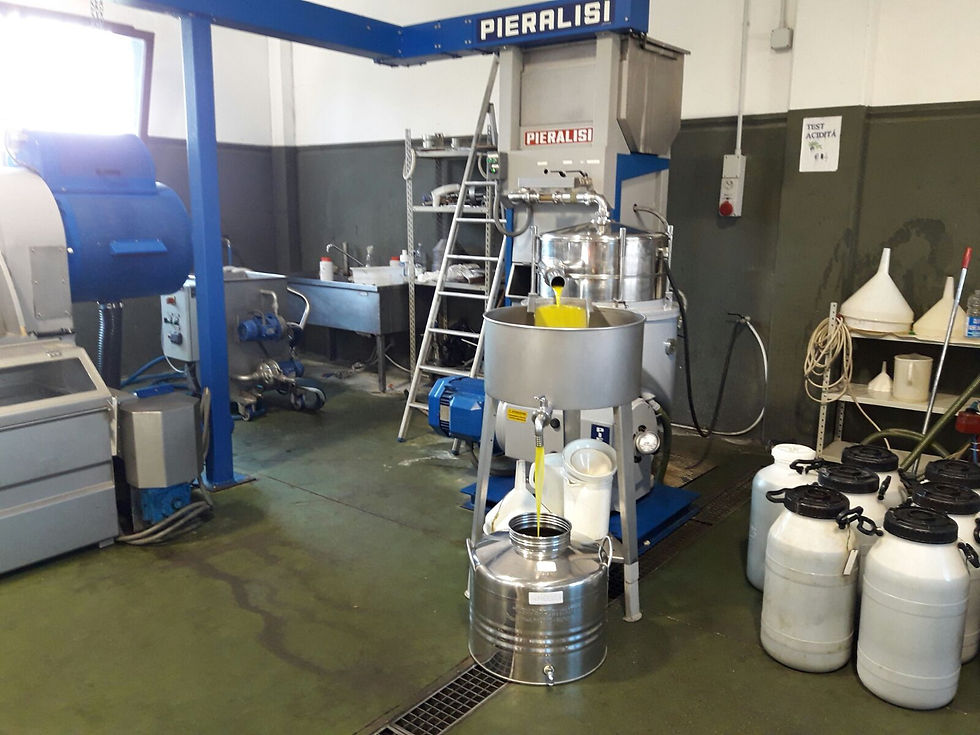
The liquids are then sent to a vertical separator. It separates water from olive oil. In this last phase the oil is filtered from water and any solid particles. The final product is poured in my father's 50 L (13.21 US gallons) steel container. The final process takes approximately twenty minutes. The olive mill does not sell containers but it lends them in case of need, so olive growers bring their own.
The extra-virgin olive oil

When my father has all his olive oil he goes with one of the staff members upstairs in the laboratory to check the acidity of the oil. They pour a small quantity in a glass and then they measure it and taste it. All is done in front of my father. This year his oil acidity is 0.1%, so he has a high quality extra-virgin olive oil. According to guidelines of European Union Law (Reg. 2568/91/CEE), when the olive oil has an acidity between 0.1% and 0.8% it is considered extra-virgin olive oil. Between 0.9% and 2% it is considered olive oil.
It is also interesting to point out how much olive oil is produced by a certain quantity of olives. This varies all the time based on multiple variables such as age of the trees, varieties of olives (cultivars), soil, climate, agricultural practices, and efficiency of the olive mill in producing the oil.
This year my father's first batch of olives, 481kg (1,060 lbs) yielded 90kg (198 lbs) of olive oil, an 18% production. His second batch of 310kg (683 lbs), yielded 41.6kg (92 lbs) of olive oils, a 13.4% production. His third and last batch of 249kg (549lbs), yielded 40kg (88lbs) olive oil, a 16% production yield. His total was: 1,040 kg (2,293lbs) of olives which yielded 171.6 kg (378lbs) of oil with 16.5% production yield. 16.5% is considered average this year. Some years the production yield is less, and other years it is more based on the variables mentioned above.
Costs for olive growers
The olive mill charges olive growers for the olive oil extraction. It charges 20 € to process between 0-300 kg (0-661 lbs) of olives, 19 € between 400-1000 kg (882-2,205 lbs) , and 18 € above 1000 kg (2,205 lbs). Instead of paying cash there is an alternative option. You can leave 3kg (6.6 lbs) of extra-virgin olive oil every 100 kg (220 lbs) and the olive mill pays for your extra-virgin olive oil 6 € per kg. The olive mill sells it at 11 € per liter. By the way, 1 kg of olive oil is not the same amount as 1 liter of olive oil: 1 L = 0.916 kg so 1 kg has more olive oil than 1 L. The reason why they measure it in kg is because during the whole process everything is measured in kg. The olive mill sells it by the liter because it is convenient.
Conservation of the extra-virgin olive oil

The olive oil is then stored in dark glass bottles or steel containers at a temperature of 15 -16°C (59 - 60.8°F). Glass bottles even smaller than a liter are preferable for daily use in the kitchen because light, heat and air contribute to extra-virgin olive oil oxidation resulting in a more rancid flavor of the oil. The extra-virgin olive oil is considered olio nuovo (new oil) for the first six months since its making.
On a closing note, if you happen to be in Tuscany in the fall there are festivals (sagre) of olive oil in many old towns. It is also possible to visit old olive mills that are otherwise closed during the rest of the year. And if you are on the coast you can also drive on the Etruscan Coast Wine and Olive Oil Road.
Pictures by Antonio Smolizza

Comments